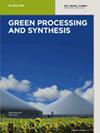Synthesis and characterization of capsaicin nanoparticles: An attempt to enhance its bioavailability and pharmacological actions
IF 3.8
4区 工程技术
Q2 CHEMISTRY, MULTIDISCIPLINARY
引用次数: 0
Abstract
Herein, capsaicin nanoparticles (NPs) were prepared by two different methods, namely, evaporative precipitation of nanosuspension (EPN) and anti-solvent precipitation with a syringe pump (APSP). The nanoparticles of the necessary sizes were obtained after optimizing experimental parameters such as the solvent-to-anti-solvent ratio and stirring speed. They had spherical shapes and an average diameter of 171.29 ± 1.94 and 78.91 ± 0.54 nm when prepared using the EPN and APSP methods, respectively. Differential scanning calorimetry and an X-ray diffractometer showed that the capsaicin crystallinity decreased. FTIR results showed that the NPs were produced with their original configuration and did not result in the synthesis of any additional structures. The NP formulation had a desirable drug content. They surpassed the unprocessed drug in solubility and displayed the desired stability. Capsaicin NP cream showed many folds of enhanced analgesic, anti-inflammatory, and antimicrobial effects compared to unprocessed capsaicin.辣椒素纳米颗粒的合成与表征:尝试提高辣椒素的生物利用度和药理作用
本文采用两种不同的方法制备了辣椒素纳米颗粒(NPs),即纳米悬浮液蒸发沉淀法(EPN)和注射泵反溶剂沉淀法(APSP)。通过优化溶剂与反溶剂的比例和搅拌速度等实验参数,制备出了所需尺寸的纳米颗粒。采用 EPN 和 APSP 方法制备的纳米粒子呈球形,平均直径分别为 171.29 ± 1.94 nm 和 78.91 ± 0.54 nm。差示扫描量热法和 X 射线衍射仪显示辣椒素结晶度降低。傅立叶变换红外光谱(FTIR)结果表明,制备的 NPs 具有原始结构,没有合成任何其他结构。NP 配方具有理想的药物含量。它们的溶解度超过了未加工的药物,并显示出理想的稳定性。与未加工的辣椒素相比,辣椒素 NP 霜的镇痛、消炎和抗菌效果增强了数倍。
本文章由计算机程序翻译,如有差异,请以英文原文为准。
求助全文
约1分钟内获得全文
求助全文
来源期刊

Green Processing and Synthesis
CHEMISTRY, MULTIDISCIPLINARY-ENGINEERING, CHEMICAL
CiteScore
6.70
自引率
9.30%
发文量
78
审稿时长
7 weeks
期刊介绍:
Green Processing and Synthesis is a bimonthly, peer-reviewed journal that provides up-to-date research both on fundamental as well as applied aspects of innovative green process development and chemical synthesis, giving an appropriate share to industrial views. The contributions are cutting edge, high-impact, authoritative, and provide both pros and cons of potential technologies. Green Processing and Synthesis provides a platform for scientists and engineers, especially chemists and chemical engineers, but is also open for interdisciplinary research from other areas such as physics, materials science, or catalysis.
 求助内容:
求助内容: 应助结果提醒方式:
应助结果提醒方式:


